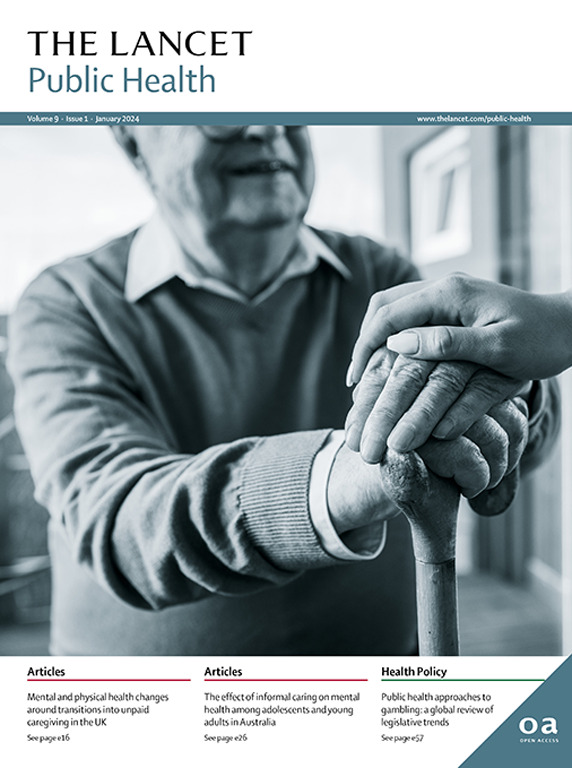Targeting alcohol use in high-risk population groups: a US microsimulation study of beverage-specific pricing policies
IF 25.2
1区 医学
Q1 PUBLIC, ENVIRONMENTAL & OCCUPATIONAL HEALTH
引用次数: 0
Abstract
Background
Raising retail prices on alcoholic beverages preferred by high-risk groups (males, those of low socioeconomic status, and those with heavy alcohol use) might selectively reduce their alcohol consumption. However, the differential impact of beverage-specific price increases on US population groups has yet to be studied. This study aimed to simulate the effect of beverage-specific price increases on alcohol use within subgroups of the adult US population defined by sex, educational attainment, and alcohol use category.Methods
An individual-level microsimulation of the US population (aged 18–79 years) was used to simulate alcohol consumption from 2000 to 2019 based on individual characteristics (ie, sex, age, race, ethnicity, and educational attainment as a proxy for socioeconomic status categorised as high school degree or less, some college, and college degree or more) and previous alcohol use. The microsimulation model was generated via integration of diverse data sources including decennial US Census data, annual data from the American Community Survey, annual data from the National Vital Statistics System, annual data from the Behavioral Risk Factor Surveillance System, and biennial, longitudinal data from the Panel Study of Income Dynamics. Policy parameters were informed by the existing literature. Four national policy scenarios were compared with a reference scenario without price change in 2019: a uniform price increase of 10% (scenario 1), a uniform price increase of 30% (scenario 2), a beverage-specific price increase of 30% for beer and spirits and 10% for wine (scenario 3), and a beverage-specific price increase of 50% for beer and spirits and 10% for wine (scenario 4). Individual-level effects on alcohol consumption were simulated using beverage-specific own-price elasticities. Sensitivity analysis assessed assumption-based correlation coefficient between alcohol consumption and the individual-level percent reduction in alcohol consumed; and the application of the beverage-non-specific own-price participation elasticity.Findings
Scenario 4 had the strongest effect on alcohol use overall and most effectively reduced consumption in high-risk groups: males and females with high alcohol use (more than 60 g of pure alcohol per day for males and 40 g of pure alcohol per day for females) and low educational attainment (high school degree or less) reduced their alcohol use by –17·30% (–17·62 g per day, credible interval [CI] –21·77 to –13·20) and –17·49% (–12·25 g per day, CI –14·72 to –9·58), respectively. In comparison, smaller relative changes were observed among groups at less risk of harm.Interpretation
Disproportionate increases in retail prices for the cheapest beverages, beer and spirits, might lead to a greater decline in consumption among high-risk groups. Pricing policies could thus be used as a powerful public health tool to mitigate the unequal alcohol-attributable burden of disease.Funding
National Institute on Alcohol Abuse and Alcoholism, National Institutes of Health.针对高危人群的酒精使用:美国饮料特定定价政策的微观模拟研究
背景:提高高风险人群(男性、社会经济地位低的人群和大量饮酒的人群)喜欢的酒精饮料的零售价格,可能会选择性地减少他们的酒精消费。然而,饮料特定价格上涨对美国人群的不同影响还有待研究。本研究旨在模拟按性别、受教育程度和酒精使用类别划分的美国成年人口亚组中特定饮料价格上涨对酒精使用的影响。方法对美国人口(18-79岁)进行个人层面的微观模拟,根据个人特征(即性别、年龄、种族、民族和教育程度,作为社会经济地位(高中或以下学历,部分大学学历,大学学历或以上)和以前的酒精使用情况,模拟2000年至2019年的酒精消费情况。微观模拟模型是通过整合各种数据源生成的,这些数据源包括十年一次的美国人口普查数据、美国社区调查的年度数据、国家生命统计系统的年度数据、行为风险因素监测系统的年度数据以及两年一次的收入动态小组研究的纵向数据。政策参数由现有文献提供。将四种国家政策情景与2019年没有价格变化的参考情景进行比较:价格统一上涨10%(情景1),价格统一上涨30%(情景2),啤酒和烈酒特定饮料价格上涨30%,葡萄酒特定饮料价格上涨10%(情景3),啤酒和烈酒特定饮料价格上涨50%,葡萄酒特定饮料价格上涨10%(情景4)。个体水平对酒精消费的影响是用饮料特有的自身价格弹性来模拟的。敏感性分析评估了酒精消费量与个人水平酒精消费量减少百分比之间基于假设的相关系数;以及饮料非特异性自价参与弹性的应用。FindingsScenario 4对饮酒的影响最强的整体和最有效地减少消耗在高危人群:男性和女性高饮酒(每天超过60克的纯酒精对男性和女性每天40 g的纯酒精)和低教育程度(高中学历或更少)减少了酒精使用-17·30%(-17·62克/天,可信区间[CI] -21·77 - -13·20)和-17·49%(-12·每天25克,CI -14·72年9·58),分别。相比之下,在危害风险较低的组中观察到的相对变化较小。最便宜的饮料,啤酒和烈酒的零售价格不成比例地上涨,可能导致高风险群体的消费大幅下降。因此,价格政策可以作为一种强有力的公共卫生工具,减轻由酒精引起的不平等疾病负担。资助国家酒精滥用和酒精中毒研究所,国家卫生研究院
本文章由计算机程序翻译,如有差异,请以英文原文为准。
求助全文
约1分钟内获得全文
求助全文
来源期刊

Lancet Public Health
Medicine-Public Health, Environmental and Occupational Health
CiteScore
55.60
自引率
0.80%
发文量
305
审稿时长
8 weeks
期刊介绍:
The Lancet Public Health is committed to tackling the most pressing issues across all aspects of public health. We have a strong commitment to using science to improve health equity and social justice. In line with the values and vision of The Lancet, we take a broad and inclusive approach to public health and are interested in interdisciplinary research.
We publish a range of content types that can advance public health policies and outcomes. These include Articles, Review, Comment, and Correspondence. Learn more about the types of papers we publish.
 求助内容:
求助内容: 应助结果提醒方式:
应助结果提醒方式:


